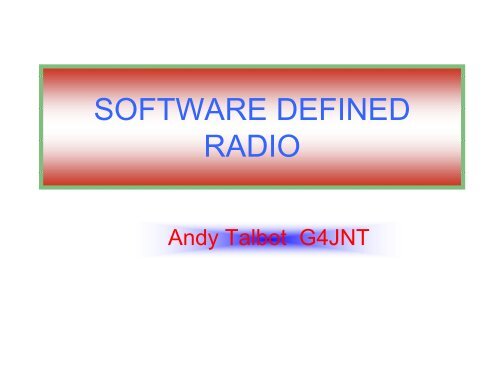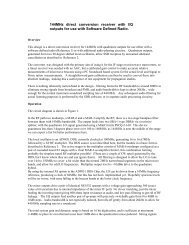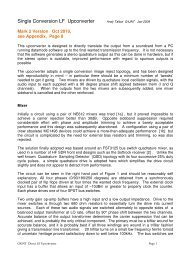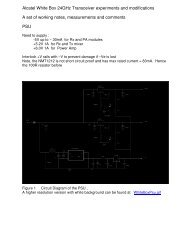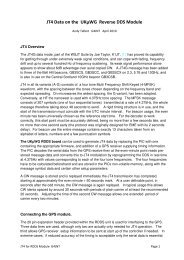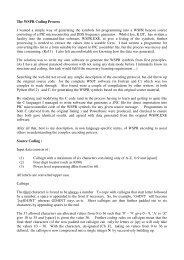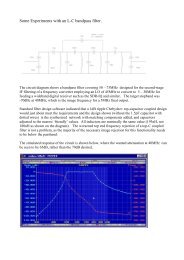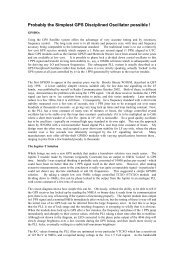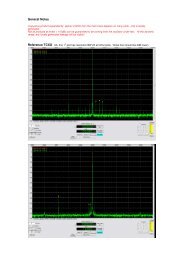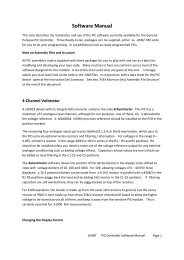You also want an ePaper? Increase the reach of your titles
YUMPU automatically turns print PDFs into web optimized ePapers that Google loves.
SOFTWARE DEFINED<br />
RADIO<br />
Andy Talbot <strong>G4JNT</strong>
The Modern Digital <strong>Radio</strong><br />
• Conventional analogue RF front end<br />
• Input filter(s)<br />
• Mixer<br />
• IF amplification<br />
• Mixer to 30kHz (typical)<br />
As for any analogue radio<br />
• Digitisation + DSP filtering /<br />
demodulation Specific to DSP radio
Conventional modern<br />
Digital Receiver<br />
IN 0 - 30MHz<br />
1st IF 40MHz<br />
2nd IF 455kHz<br />
3rd If 30kHz<br />
Single Chip<br />
DSP<br />
Computer<br />
1st LO<br />
Synth.<br />
100kHz sampling<br />
D/A<br />
AGC
What Digital IF Processing can do<br />
• Unlimited filter bandwidths / shapes<br />
– Without expensive crystal or mech. filters<br />
• New modulations, analogue or digital<br />
• No-Hardware upgrade, software<br />
download only<br />
•BUT<br />
• Still needs RF and first crystal filter, two<br />
or more I/Fs, mixers
The <strong>Software</strong> <strong>Defined</strong> <strong>Radio</strong><br />
• Natural progression from the DSP <strong>Radio</strong><br />
• Digitise a large chunk of RF spectrum in<br />
one go<br />
• Downconvert and filter in software<br />
• One frequency conversion only, or<br />
possibly none at all !
TYPICAL SOFTWARE DEFINED<br />
RADIO ARCHITECTURE<br />
Digital<br />
Downconverters<br />
0 - 30MHz RF<br />
Input<br />
A/D<br />
D/A<br />
VHF/UHF<br />
Input<br />
VHF Converter<br />
Sample Clock<br />
80MHz<br />
Synthesizer<br />
Controller, Tuning, Mode<br />
Select, Bandwidth, Front<br />
Panel Controls, Data<br />
Demod, etc etc
A/D Converters<br />
• Digitisation of spectrum dictates design<br />
of SDR<br />
– Current state of the art has been defined<br />
by the cellphone industry<br />
– Many MHz of spectrum in one go.<br />
– 14 bits is common, 16 bits beginning to<br />
appear. Device speed rising to 80MHz (3G<br />
phone technology) Number of bits<br />
dictates dynamic range<br />
– Analog Devices AD6645
A/D Converters cont.<br />
• 6dB per bit means we can have<br />
theoretically 84dB dynamic range -<br />
although in practice more like 75dB over<br />
full bandwidth<br />
• Rising to 85-90dB soon.<br />
• Almost good enough for HF just by<br />
connecting antenna to A/D chip via LPF.<br />
• BUT, after digital filtering processing<br />
gain give higher dynamic range
SDR. Architecture<br />
• A/D converter<br />
• Numerical controlled oscillator for tuning<br />
• Downconvert to two 90 degree channels<br />
using zero freq IF<br />
• Filter to lower bandwidth, reduce<br />
sampling rate (decimation) - processing<br />
gain<br />
• Demodulate
Advantages<br />
• No bandswitching, filters or wideband<br />
Local Oscillator for HF radio<br />
• Single conversion for V/UHF means<br />
simple filtering and synthesizer, fewer<br />
sprogs<br />
• Any mode possible - voice, digimode,<br />
• Wideband / narrowband<br />
• Rapid frequency agility
Current Technology<br />
• AD6645 - 14bit, 80MHz sampling<br />
– Continuously improving<br />
– New devices appearing each year<br />
• Entire HF spectrum in one go (almost)<br />
• Digital downconverter chips<br />
– Numerical LO and filtering with<br />
demodulation in one chip<br />
– Multiple channels simultaneously
Digital Downconverter
Simpler Solutions<br />
(The Homebrew option ?)<br />
• I/Q conversion<br />
– Single LO downconvert to zero frequency<br />
– Needs accurate 0/90º phase split for<br />
sideband isolation<br />
– Matched I/Q low pass filters<br />
• But if these can be done :
The PC SDR.<br />
• I/Q Convert and low pass filter to audio<br />
bandwidth<br />
– One LO only (with 0/90º outputs)<br />
– Two matched mixers<br />
• Use PC soundcard as I/Q input<br />
– Typically up to 20kHz audio bandwidth<br />
– Giving 40kHz total !<br />
• Demodulate and filter in PC
PC Based SDR From QEX Jul/Aug 2002
PC Based SDR From QEX Jul/Aug 2002
• Soundcards do not respond to DC, so<br />
may have a notch at centre freq (or use<br />
offset)<br />
• Requires the ability to write Windows<br />
software for Soundcard<br />
• OR use a separate DSP card - stand<br />
alone radio
Conclusions<br />
• SDR gives the ultimate flexibility<br />
• One piece of hardware allows virtually<br />
any band / modulation format<br />
• Easy upgrade route<br />
• Fast reconfiguration<br />
• Cheaper ?????


